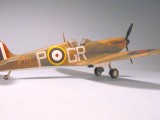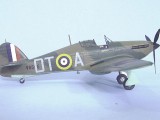Roland Robert Stanford-Tuck
Roland Robert Stanford-Tuck, with 30 victories one of the top RAF aces of the Second World War, joined the RAF in 1935 at age 19 on a short service commission, following two years at sea as a cadet.
Tuck did not at first take to flying, and was nearly “bowler-hatted” for not soloing until he had 14 hours (most pilots solo around 7-8). From there on it was “tea and biscuits” as they say. After training on the Avro Tutor, Hawker Hart, Hawker Fury and the Bristol Bulldog, Tuck passed out of No. 3 Flying Training School at Grantham with the highest rating available - "exceptional."
Posted to 65 Squadron at Hornchurch in July 1936, Tuck flew Demons until they were replaced at the end of the year with Gloster Gauntlets, followed in late 1937 by Gladiators. During this period, Tuck was involved in a mid-air collision during formation aerobatics training, and again came close to being kicked out of the service, but was found not to have been at fault in the accident. Shortly thereafter, 65 Squadron re-equipped as the second squadron to use the Spitfire I shortly after the Munich Crisis.
By the outbreak of war in September 1939, Tuck had several hundred hours on Spitfires. Confined to the U.K. during the period of the “Phoney War,” Tuck was promoted to Flight Lieutenant and transferred to 92 Squadron in the Spring of 1940 to take over Red Flight lead. He first got a taste of the war on May 16, when he and his two wingmen were given top secret orders to fly to Hendon, where they were assigned as fighter escort to an un-armed twin-engined Flamingo. This turned out to be Winston Churchill's flight to France following his acceptance as Prime Minister, to try and prevail on Paul Reynaud to hold out in the face of the German blitzkrieg that had been unleashed six days earlier. They returned, unsuccessful, the next day and Tuck's flight returned to their squadron.
With the British Expeditionary Force forced to retreat to Dunkirk for evacuation by the Royal Navy, Tuck's first aerial combat took place over Dunkirk on 23 May 1940. On this first mission, he shot down a Bf-109E. On a second mission that afternoon, he shot down two Bf-110s, with a third 110 shot down on the final mission of the day. Having chased that last opponent inland, Tuck had become separated from his flight and ended up in combat without ammo with two Bf-109s which he outflew on a daring low-level escape across the Channel back to England.
92 Squadron was in 11 Group, and over the summer Tuck took part in numerous combats over the Channel. His combat success continued: a shared Do17 on July 8th; a damaged Ju88 on July 25th; a shared Ju88 on August 13th and two destroyed Ju88's on the 14th. On August 18th, Tuck attacked a group of Ju88's over Kent, shooting down one and damaging another. During the fight, his Spitfire was hit by return fire and he baled out just east of Tunbridge Wells where he was slightly injured from the landing. He was involved in another incident on August 25th, 15 miles off the coast over the Channel; his Spitfire was badly damaged while attacking and destroying a Do17, which he destroyed. With a dead engine and the alternative of a likely-fatal dunking in the Channel, Tuck glided back to the coast to make a forced landing on the Downs.
On September 11th, at the height of the Battle of Britain, Tuck was promoted to Squadron Leader and posted to command 257 Squadron based at Debden. 257 had been through heavy combat and was in a sorry state on Tuck's arrival, having lost their C.O. in combat. He checked out in a Hurricane the next day and put the pilots through some intensive flying during the three days “down time” they were given. On September 15, 1940, 257 returned to combat. Leading the squadron into combat over London, Tuck shot down a Bf-110 and a probable Bf109. (In 1978, the Aircraft Recovery Group excavated the remains of a Bf-109 22 feet deep in the marshes, still containing the remains of the pilot, Lt. Werner Knittle; after considerable research, it was determined this was the Bf-109 Tuck had claimed on September 15, bringing his official wartime score to 30.)
On September 23rd Tuck claimed another Bf-109, a Ju88 on October 4th a Bf109 on October 12th and a Bf-109 and two damaged on October 25th. His final victories in the Battle of Britain were on October 28th, he claimed two “probable” Bf109's.
Tuck remained with 257 Squadron until May, 1941, when he was promoted to Wing Commander and given command of the Duxford Wing. That October he was taken off operations after more than a year of steady combat and sent to the United States to tour American flight training schools and lecture on air combat. He also flew all of the American fighters as part of an Air Ministry assessment program.
Tuck returned at the end of November 1941 and was given command of the Biggin Hill Wing, the premiere organization in Fighter Command, a unit with four Spitfire Squadrons. On January 27, 1942, he was shot down by ground fire over Northern France while on a “Rhubarb” and taken prisoner by the Germans.
In January 1945, as the prisoners in Stalag Luft III were marched west in the face of the advancing Red Army, Tuck and three comrades escaped in a snow storm and hid in the woods, then made their way across the lines into Poland. They nearly starved before being able to give themselves up to Soviet infantry, who nearly shot them at first.
Tuck was back in England in April 1945, and began flying Vampires and Meteors at Tangmere and West Raynham. In 1946 he was promoted Station Commander at Coltishall, then moved on to Singapore with the outbreak of the Malayan Emergency. He retired from the R.A.F. in 1949.
In 1983, I had the privilege of meeting Wing Commander Tuck when he was brought to the United States by Virginia Bader, niece of Douglas Bader and at the time a well-known gallery owner here in Los Angeles, promoting aviation art. Tuck came with Johnny Johnson, who turned out to be as condescending to “colonials” as I had been told he was by a couple of old RCAF pilots who had served under him. Bader was his usual "verbal hand grenade" where one looked to see whether or not the pin had been pulled. “Bob” Tuck (as he told everyone to call him) was the polar opposite and a real hit with his American audience; Johnson on the other hand was a good reminder why my ancestors gave the bloody English the boot back in 1776.
The models here are Tuck's Spitfire I he flew with 92 Squadron at Dunkirk, done with Victory Productions "Spitfire Aces of the Empire" sheet I had a hand in developing back in 2000. The Hasegawa Hurricane I is his first Hurricane flown with 257, in which he scored most of his victories, done with Aeromaster 48-665 “Early Hurricane Aces of the British Empire 1939-40, Pt. III" .
I highly recommend "Fly For Your Life", Tuck's biography, written by Larry Forrester, available in many editions from different publishers and different physical quality, at Amazon.com













You've obviously done a lot of research here, Tom, and your enthusiasm show through. The models look brilliant (as usual), any chance you could tell us a bit more about the build (especially the Hurricane).
Thanks
George
The Hurricane is an OOB build, other than using a vacuform canopy (mandatory if you want to open it), seatbelts made from lead foil (from back when wine bottles had that). To me the one big problem with the Hasegawa kit is that stupid lower wing design that cuts across the fabric effect with a seam I never can seem to really hide other than to put a lot of stain down there.
I've read "Fly for your life" and have recently watched a BBC special on the Spitfire which was shown on television back in 1976 showing a interview with Tuck and Bader. Had to watch the BoB again on Net Flex because it. Stanford- Tuck's bio is fascinating reading where truth is stranger than fiction and worthy of being made into a "Movie" or a series for cable. Once there where flesh and blood hero's who weren't manufactured by the media or the military. Now we have comic book hero's like Iron man and Sports hero's on steroids to entertain us...
Good models by the way.
i read fly for your life 40 years ago...possibly the finest book i've ever read...i gave it to my mom who enjoyed it thoughly...the thing with his brother -in-law blew my mind...i used to frequent virginia's art studio in alexandria va. where i met robin olds in the early 90's and bought many prints...fine job on both of these...it's all ways been in the back of my mind to build his spit and hurricane so i really appreciate this...wonderful job on both and the connection
Incredible work, Tom. I especially like your posts because of the detailed historical background you provide with your builds. As an avid historian myself, the background information you provide really adds context to your work. Thanks for providing this information, along with your superb models.
Tom,
I really enjoyed this insight on Tuck. I have always been interested in him not only for his record of victories but for his name. I liked the ring to it. I also met Johnson at a Virginia Bader showing. I didn't detect his attitude perhaps because he was overshadowed by Virginia. Zempke introduced us and he was very well suited to hold his own. I like your writings and look forward reading them.
Hub Zemke could definitely hold his own with anyone. As to Johnson, it might have been an off-day, but back when I was in the military I had cause to know some of "James Bond's friends" among the English there in Hong Kong, and there is a certain "old school attitude" you come to recognize after awhile.